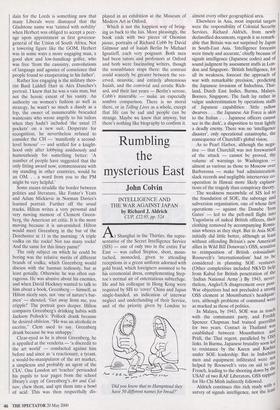Rumbling the mysterious East
John Colvin
INTELLIGENCE AND THE WAR AGAINST JAPAN by Richard J. Aldrich CUP, £22.95, pp. 524 At Shanghai in the Thirties, the repre- sentative of the Secret Intelligence Service (SIS) — one of only two in the entire Far East — was called Steptoe, short, mous- tached, monocled, given to attending receptions in a green uniform adorned with gold braid, which foreigners assumed to be his ceremonial dress, complementing Step- toe's normal air of ostentatious subterfuge. He and his colleague in Hong Kong were required by SIS to 'cover' China and Japan single-handed, an indication of interwar neglect and underfunding of their Service, and of the priority given by London to Did you know that in Hampstead they have 50 different names for bread?' almost every other geographical area.
Elsewhere in Asia, most imperial targets were the responsibility of Colonial Security Services. Richard Aldrich, from newly declassified documents, regards it as remark- able that Britain was not surprised by Japan in South-East Asia. 'Intelligence forecasts were timely and accurate,' chiefly because of signals intelligence (Japanese codes) and of sound judgment by assessment staffs in Lon- don and Singapore. 'British Intelligence, for all its weakness, forecast the approach of war with remarkable precision,' predicting the Japanese invasions of Indochina, Thai- land, Dutch East Indies, Burma, Malaya, Borneo, Singapore. The fault lay rather in vulgar underestimation by operations staffs of Japanese capabilities: 'little yellow dwarves . . . the Japanese Air Force is akin to the Italian . . . Japanese officers cannot see in the dark', a disposition to treat lightly a deadly enemy. There was no 'intelligence disaster', only operational catastrophe, the consequence of Churchill's global vision.
As to Pearl Harbor, although the nega- tive — that Churchill was not forewarned of the attack — cannot be proved, the volume of warnings to Washington — almost as various as those to Moscow over Barbarossa — make bad administration, slack records and negligible interservice co- operation in Hawaii more likely explana- tions of the tragedy than conspiracy theory. The weakness meanwhile of SIS led to the foundation of SOE, the sabotage and subversion organisation, one of whose first operations — against the Danube 'Iron Gates' — led to the pell-mell flight int° Yugoslavia of naked British officers, their clothing removed by accompanying Roma- nian whores as they slept. But in Asia SOF initially did little better, although at least without offending Britain's new American allies in Wild Bill Donovan's OSS, sensitive to reimposition of British colonialism: Roosevelt's 'internationalism' had to be considered in planning SOE ventures- (Other complexities included NKVD help from Kabul for British penetration of the 'Indian National Army'.) By 1943, never- theless, Anglo/US disagreement over cost' War objectives had not precluded a strong OSS element at Mountbatten's headquar- ters, although problems of command were as marked as those of politics. In Malaya, by 1943, SOE was in touch with the communist party, and Freddy Spencer Chapman had trained guerrillas for two years. Contact in Thailand was, established between Mountbatten and Pridi, the Thai regent, paralleled by OS, links. In Burma, Japanese brutality soon le,a to resistance by the Karen and Knell 111 under SOE leadership. But in Indochina men and equipment infiltrated were not helped by Roosevelt's veto on aid to the French, leading to the shooting down by the USAF of two RAF Liberators. OSS supped' for Ho Chi Minh indirectly followed. , Aldrich continues this rich study wall "t survey of signals intelligence, not the leas bizarre revelation being that the British Eastern Fleet suffered a less severe defeat by preferring the old eye-ball method to the new science. But Bletchley was as vital in this theatre as in all others, and was so acknowledged by commanders.
In mainland China there were, at one point, 16 separate intelligence organisations tied to different indigenous 'secret' services. (In one French mission, the registry super- vised by a Mrs Dean, alias Mrs Whisky, secret documents disappeared at an alarm- ing rate.) Count Tolstoi's grandson led an OSS mission with British support to the Dalai in Tibet. Chou En-Lai himself was in touch with SIS, who reported well on Yenan, and it is remarkable, given ideologi- cal battles within the US administration, that a visit to Roosevelt in mid-war was even Considered by Mao and Chou; an OSS- backed communist offensive against the Japanese was also discussed. SOE's chief distinction, other than guerrilla training and wireless/telegraphy, was to maintain itself, ICI, Reuters and the Red Cross in China, entirely out of the currency black market. Richard Aldrich, in this invaluable account, is in no doubt that 'arms supplies and training in insurgency contributed to the erosion of civil society in Asia, and began a Process easier to initiate than to arrest'. As to the organisations themselves, SIS was saved by the ending of the war and the return to long-term objectives which ren- dered otiose the existence of SOE, while the PA subsumed most of the US groups. Sig- t, of course, survived, indeed flourished.










































































 Previous page
Previous page